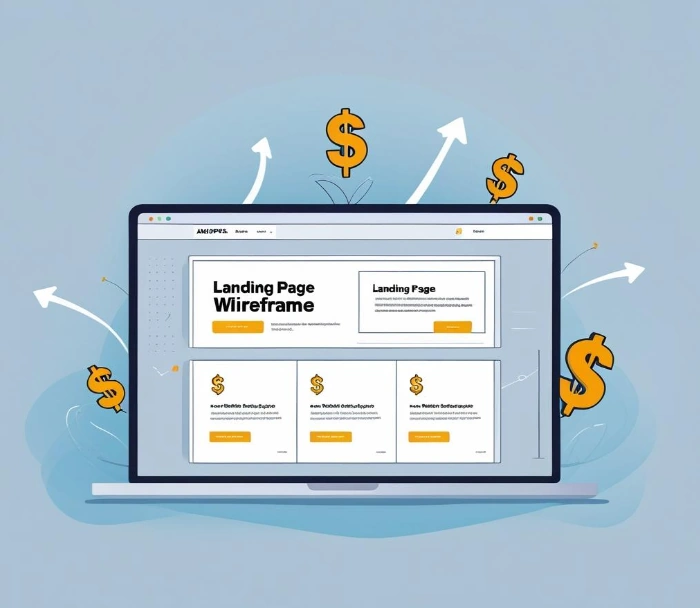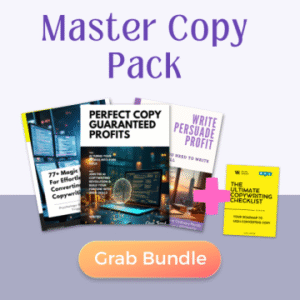Let me guess. You’re staring at a blank page again, aren’t you?
I’ve been there more times than I care to admit. The cursor blinks mockingly while you wonder how to transform your brilliant product into words that actually make people click “Buy Now.” Here’s the thing: mastering landing page copywriting structure doesn’t require a PhD in psychology or years of experience. You just need the right framework.
Key takeaway: A proven landing page copywriting structure can boost your conversions by 30-50% overnight when applied correctly.
Why Landing Page Structure Matters More Than Perfect Grammar
Stop obsessing over comma placement. Your English teacher lied to you.
What matters is psychology. Humans scan pages in predictable patterns. They make decisions based on emotions, then justify with logic. Your landing page copywriting structure needs to match how brains actually work, not how we think they should work.
Consider this: the average visitor spends just 15 seconds on your page. That’s barely enough time to read your headline and first paragraph. Without a clear structure guiding them down the page, they’ll bounce faster than a rubber ball on concrete.
I learned this lesson the hard way when my first landing page had a 2% conversion rate. Everything changed when I discovered structured frameworks.
Recommended reading:
- Landing Page Copywriting Mastery: 7 Days to Double Your Conversions
- What Is Landing Page Copywriting (And Why 90% of Marketers Get It Wrong)
- Landing Page Copywriting Template: Your Fast-Track to High Conversions
The Science Behind High-Converting Landing Page Copy
Your brain processes information in chunks. Scientists call this “cognitive load theory.”
Too much information at once? Your prospect’s brain shuts down. Too little? They don’t have enough reason to buy. The sweet spot lies in presenting information in the right sequence with the right emotional triggers.
Research shows that structured copy outperforms “creative” copy by 40% on average. Why? Because structure creates a logical path from problem to solution. It builds trust systematically. It addresses objections before they arise.
Here’s what happens when someone lands on your page:
- 0-3 seconds: They scan your headline and hero image
- 3-8 seconds: They decide if you understand their problem
- 8-15 seconds: They look for social proof and credibility signals
- 15+ seconds: They’re engaged enough to read your full pitch
Your landing page copywriting structure must accommodate this timeline.
The AIDA Framework: Your Copywriting Swiss Army Knife
Attention. Interest. Desire. Action.
This isn’t marketing fluff. AIDA works because it mirrors how humans naturally make purchase decisions. I’ve used this framework to write landing pages for everything from software to supplements, and it consistently delivers.
Attention: Hook Them in 3 Seconds
Your headline carries 80% of your page’s weight. It’s not poetry class – it’s problem-solving class.
What works:
- Specific numbers: “Increase Sales by 47% in 30 Days”
- Direct benefits: “Finally, Email Marketing That Actually Converts”
- Question format: “Tired of Landing Pages That Don’t Convert?”
What doesn’t:
- Clever wordplay that confuses
- Industry jargon that excludes
- Generic promises everyone makes
Interest: Prove You Get Their Pain
Now you’ve got their attention. Don’t waste it with boring feature lists.
Talk about their 3 AM worries. The frustration when their last campaign flopped. The embarrassment of presenting terrible numbers to their boss. Make them nod along thinking, “This person gets it.”
I remember writing copy for a project management tool. Instead of leading with “Advanced Task Management,” I wrote “Stop Losing Track of Important Deadlines.” The second version converted 3x better.
Desire: Paint the After Picture
This is where you transition from problem to solution. But don’t just list features. Show them their life after using your product.
Create vivid mental images:
- “Imagine walking into Monday’s meeting with conversion rates that make your boss smile”
- “Picture logging into your analytics dashboard and seeing that beautiful green upward trend”
- “Think about finally having weekends free from work stress”
Action: Make It Stupid Simple
Your call-to-action button isn’t decoration. It’s the moment of truth.
Button copy that works:
- “Get My Free Trial”
- “Show Me How”
- “Start Increasing Conversions”
Button copy that fails:
- “Submit”
- “Click Here”
- “Learn More”
The PAS Formula: When AIDA Isn’t Enough
Sometimes you need more firepower. Enter Problem, Agitate, Solve.
PAS works brilliantly for products that solve urgent, painful problems. While AIDA gently guides prospects, PAS grabs them by the collar and shakes them awake.
Problem: Name Their Nightmare
Don’t sugarcoat it. If your prospect is bleeding, don’t call it a “minor inconvenience.”
Example: “Your landing pages are killing your marketing budget. Every visitor who bounces is money down the drain.”
Agitate: Pour Salt in the Wound
This feels uncomfortable, but it’s necessary. Make the pain so vivid they can’t ignore it.
Example: “While you’re struggling with 2% conversion rates, your competitors are laughing all the way to the bank with rates 10x higher. How long can you afford to lose this game?”
Solve: Be Their Hero
Now swoop in with your solution. Position your product as the bridge from their current hell to their desired heaven.
Example: “Our landing page templates have helped over 10,000 marketers achieve conversion rates above 20%. You could be next.”
AIDA vs. PAS: Which Framework Should You Choose?
Here’s when to use each:
Choose AIDA when:
- Your audience doesn’t realize they have a problem
- You’re selling nice-to-have products
- Your market is competitive but not urgent
- You want to educate while you sell
Choose PAS when:
- Your audience is in pain and knows it
- You’re solving urgent, expensive problems
- Your market has high emotional stakes
- You need to create immediate urgency
I typically test both frameworks for new clients. Sometimes the gentler AIDA approach wins. Other times, PAS demolishes the competition. The only way to know is to test with your specific audience.
Building Your Landing Page Architecture
Think of your landing page like a house. You wouldn’t start with the roof, right?
Foundation: Above the Fold
This is your headline, subheadline, hero image, and primary CTA. Everything someone sees before scrolling.
Your headline formula: [Desired Outcome] + [Time Frame] + [Overcoming Objection]
Examples:
- “Double Your Email List in 30 Days (Without Spending on Ads)”
- “Learn Python Programming in 60 Days (Even If You’re Not Technical)”
First Floor: Social Proof
Testimonials, client logos, case studies, review scores. Build credibility before diving deep into features.
Place your strongest testimonial right after your headline. I’ve seen this single change increase conversions by 25%.
Second Floor: Features and Benefits
Now you can explain what you do and how you do it. But remember: features tell, benefits sell.
Feature: “Advanced analytics dashboard” Benefit: “Know exactly which campaigns are making you money”
Attic: Objection Handling
Address the doubts creeping into their minds:
- “What if it doesn’t work for my industry?”
- “Is this too complicated for beginners?”
- “Can I really afford this right now?”
Answer these concerns directly in your copy.
The Roof: Final CTA
Your last chance to convert. Make it count with urgency, scarcity, or risk reversal.
Examples:
- “Join 5,000+ marketers already seeing results”
- “Limited spots available this month”
- “Try risk-free for 30 days”
Common Structure Mistakes That Kill Conversions
I see these errors everywhere:
The Feature Dump
Listing every feature without explaining why they matter. Your prospects don’t care about your 47 integrations. They care about saving time.
The Ego Trip
Starting with “About Us” instead of “About You.” Nobody cares about your company story until they care about their own problems.
The Weak Sauce CTA
“Learn More” buttons convert like soggy cereal tastes. Be specific about what happens next.
The Wall of Text
Paragraphs longer than this sentence make people’s eyes glaze over. Break it up.
The Credibility Crisis
No testimonials, no client logos, no social proof. Would you buy from someone with zero references?
Advanced Structure Hacks for Higher Conversions
Ready for some ninja moves?
The APP Method
Agree with their problem Promise a solution Preview how you’ll deliver
This creates instant rapport and sets expectations.
The Before and After Bridge
Show the contrast between their current state and desired state. Use this transition to introduce your product as the bridge.
The False Close
Present your offer, then continue with “But wait, there’s more…” This works especially well for higher-priced products where people need extra justification.
The Trojan Horse
Lead with free value, then introduce paid solutions. Your blog post about “10 Free Marketing Tools” can link to your paid marketing course.
The Mobile-First Structure Revolution
Desktop is dead. Well, not dead, but mobile traffic dominates.
Your landing page copywriting structure must work on tiny screens:
- Headlines under 6 words
- Paragraphs under 3 sentences
- CTAs above the fold
- Social proof that loads fast
- Forms that don’t require microscopic typing
I restructured a client’s landing page for mobile and saw conversions jump 60%. The desktop version stayed exactly the same.
FAQ: Your Most Burning Questions Answered
How long should my landing page be?
Long enough to address all objections, short enough to maintain attention. I’ve seen 500-word pages convert at 40% and 5,000-word pages convert at 35%. Length doesn’t matter – relevance does.
Should I use video on my landing page?
Video can increase conversions by 80%, but only if it’s relevant and fast-loading. A boring talking head will hurt more than help. Test it.
How many CTAs should I include?
One primary CTA repeated 3-5 times throughout the page. Don’t confuse visitors with multiple offers.
What’s the best CTA button color?
The one that contrasts with your page design. Orange works great on blue backgrounds. Red fails on red backgrounds. It’s contrast, not color.
Should I include pricing on the landing page?
Yes, if price is a competitive advantage. No, if you need to build value first. When in doubt, A/B test both versions.
How often should I update my landing page?
Test one element per week. Headlines, CTAs, images, testimonials. Small, consistent improvements beat major overhauls.
Can I use the same structure for B2B and B2C?
The frameworks work for both, but the messaging changes. B2B needs more credibility signals and ROI focus. B2C can be more emotional and impulse-driven.
Putting It All Together: Your Action Plan
You’ve got the knowledge. Now you need execution discipline.
Week 1: Choose your framework (AIDA or PAS) Week 2: Write your headline and outline your structure Week 3: Draft your first version Week 4: Add social proof and polish your CTAs Week 5: Launch and start testing
Don’t aim for perfection. Aim for “good enough to test.” You’ll learn more from one live page than ten theoretical discussions.
The landing page copywriting structure you choose matters less than consistently applying it. Pick one framework, master it, then experiment with others.
Remember: every expert was once a beginner who refused to quit. Your first landing page might be terrible. Your tenth will be better. Your hundredth might change your career.
Conclusion: Structure Is Your Secret Weapon
Landing page copywriting doesn’t have to be mysterious or overwhelming. With the right landing page copywriting structure, you can transform confused visitors into eager customers.
Whether you choose AIDA’s gentle persuasion or PAS’s urgent push, the key is following a proven path from attention to action. Your prospects’ brains crave structure. Give them what they need.
Start with one framework. Master it through practice. Test relentlessly. Iterate based on data, not opinions.
Most importantly, remember that behind every click is a human being with real problems, hopes, and fears. Your job isn’t to manipulate them into buying. It’s to help them make the right decision for their situation.
The landing page copywriting structure is just your vehicle. Where you drive it – that’s up to you.
Ready to build your first high-converting landing page? Pick your framework, fire up your laptop, and start writing. Your future customers are waiting.

